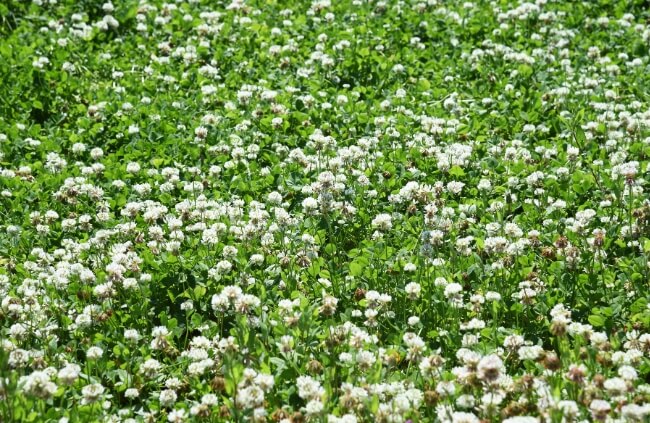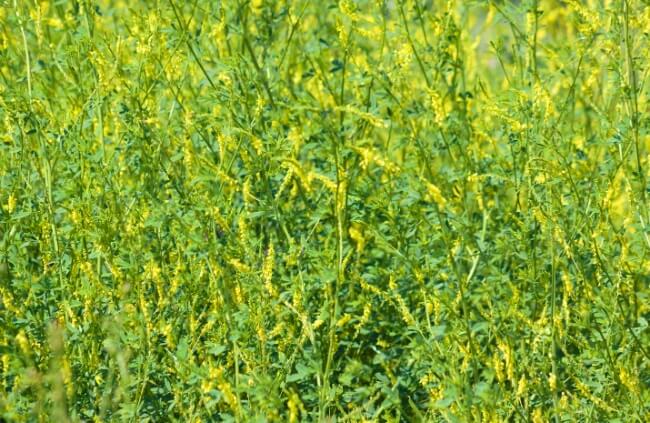Clover varieties are named after the colour of their blooms, such as red clover (Trifolium pratense) and white clover (Trifolium repens). Depending on the type of clover, a clover field can serve as forage for wildlife or as a lawn for a homeowner.
Red clover grows to 90 centimetres and is best suited for grazing. For homeowners, Dutch white clover grows close to the ground and makes a drought-resistant lawn addition that needs little fertilising.
Clover adds nitrogen to the soil and when planted with grass, it reduces the need for lawn maintenance. Since clover attracts bees, it is beneficial to the ecosystem. Sweet clover (Melilotus spp.) is a sweet-scented, upright, broad-leaved legume.
More...
Growing Different Types of Clover

How to Add White Clover to Your Lawn
Plant white clover seed mixed in with grass seed. First, mow your lawn to make it easy for the clover seeds to reach the ground. Then rake the grass with a metal rake roughly to expose the soil surface.
Buy 50 to 230 grams of clover seeds per 90 square metres. Base the weight on whether you want the grass or the clover to be the primary lawn. Clover takes over at the rate of 230 grams per 90 square metres.
In the spring, broadcast the seeds by hand or with a spreader. To ensure the clover is evenly spaced, sow the grass seed first and then the clover seed. (If you’re sowing a new lawn on bare soil, make sure that the seed mix is 15 parts grass seed to 1 part clover seed.)
Irrigate the lawn immediately after sowing the clover seeds, and keep the soil consistently moist until germination. When the seedlings become established, give your yard a good soaking whenever the plants wilt.
Mow the lawn close (4 to 5 centimetres) until the clover is established. This helps the clover to spread. If possible, stop mowing for about a month in mid-summer to allow the clover to pollinate. This enhances the health of the clover and the plants around it as well.
How to Grow a Red Clover Pasture

Red clover makes ideal pasture and hay for livestock and provides good nutrition for wildlife. As a cover crop, it adds nitrogen to the soil, increasing the soil’s quality. Also, it grows well in nearly any temperate climate and in soils with a pH level of 6.0 to 6.5.
Red clover requires good drainage and can tolerate slightly acid soil. As with white clover, have a soil test done to see if your soil is deficient in any nutrients.
Inoculate your clover seed with the bacterium Rhizobium trifolii. Inoculation with this bacterium helps the root nodules to develop so that they can release nitrogen into the soil.
Plant as a companion crop with other grains, or if growing a plot of pure clover, seed each acre with 5 to 6 kilograms of seed. For seeding with a companion crop, use 3 to 4 kilograms. Sow no deeper than 0.6 centimetres and ensure good soil to seed contact.
Cultivation of Sweet Clover
Sweet clover is an excellent source of nectar and pollen for honey bees, producing large quantities of high-quality honey. In addition to bee pasture, it is used for hay, soil improvement, silage and seed production.
It likes sun but will tolerate light shade and thrives in a wide range of soil and climatic conditions; however, the soil must be well-drained and alkaline.

Sweet clover should be sown in early spring or late summer. New seedlings should be inoculated with the proper nitrogen-fixing bacteria. Sweet clover will self-seed in light soils and is sensitive to herbicide. Thin or transplant the plants 45 centimetres apart. Leaves and flowers may be harvested anytime.
How to Get Rid of Clover in Your Garden
While some homeowners see clover as a boon that adds nutrients to the soil and attracts bees, others see clover as a weed that chokes out grass. Although a broadleaf herbicide will kill most clover, it will also kill all the grass and plants around it. Fortunately, there are some natural ways to try to eradicate clover.
If using an herbicide, it is best to apply in mid spring to late summer when the red clover plants have matured and are about to produce flowers. If any of them have flowered, pull them up by hand, making sure to carefully pull the roots out of the soil. It is important to remove these mature plants before the seeds disperse.
To get rid of clover without harming other vegetation, wait until early spring and apply corn gluten meal with a spreader at a rate of 9 kilograms per 90 square metres. Water the area thoroughly with a garden hose or sprinkler system to dissolve most of the corn gluten meal into the soil.
In mid-August reapply the corn gluten meal in the same amount that you used in the spring. This second application prevents any clover seeds left in the ground from germinating. Corn gluten meal is effective only against seeds, not existing plants.
Another safe method for clover control is to cut your grass high; this will prevent the weed seeds from growing by cutting off sunlight.
If you have large clumps of white clover, an effective strategy is pouring white vinegar over the affected areas. This will make the soil too acidic for the clover to survive. Later, pull up the clover debris and plant grass seed in these areas.
Published on June 7, 2023 by Nathan Schwartz
Last Updated on January 28, 2024




